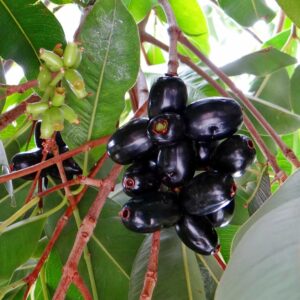Introduction
The pomegranate is a fruit-bearing deciduous shrub or small tree that is native to the Middle East and South Asia. It is scientifically known as Punica granatum and belongs to the family Lythraceae.
Pomegranate plants have a rounded shape with multiple branches. The leaves are glossy and narrow, and the flowers are usually bright red or orange and bloom in the late spring and summer.
The fruit of the pomegranate is round and typically about the size of an apple, with a thick, leathery skin that ranges in color from yellow-orange to deep red or purple. Inside, the fruit is filled with hundreds of small, juicy seeds called arils, which are surrounded by a tart, slightly sweet flesh.
Pomegranate fruit contains water-soluble pigments called anthocyanins, which are responsible for its deep red color. These pigments also have health benefits, including antioxidant and anti-inflammatory properties.
Click on the headings to read more!
Growth
Pomegranate plants are relatively slow-growing compared to some other fruit trees. They typically grow around 30-60 cm (1-2 feet) per year and can reach a mature height of 2-4 meters (6-12 feet) after 3-4 years.
Once pomegranate plants begin to produce fruit, they can continue to do so for many years, with some trees remaining productive for 20 years or more. However, the quality and quantity of fruit produced can decline over time, and many growers choose to replace older trees with younger ones to maintain optimal fruit production.
Benefits
Pomegranate is a nutrient-rich fruit with high antioxidant content, which may reduce the risk of chronic diseases. It is also a good source of fiber, vitamins C and K, and contains compounds that have anti-inflammatory and potential anti-cancer properties. Pomegranate may also help improve blood flow, lower blood pressure, and support cognitive function.
Plant care
Sunlight:
Pomegranate plants require full sun exposure for at least 6 hours a day to produce fruit. They prefer a sunny location that is protected from strong winds.
Soil:
Pomegranate plants prefer well-drained soil with a pH between 5.5 and 7.0. They do not tolerate waterlogged soil, so it is necessary to ensure proper drainage. Amend the soil with organic matter like compost or aged manure before planting to improve soil structure and fertility.
Water:
Pomegranate plants require regular watering, especially during the first few years after planting. Water deeply once a week during the growing season and reduce watering in the winter. Avoid overwatering, as this can cause root rot and other problems.
Fertilizer:
Apply a balanced fertilizer in early spring and again in early summer to promote healthy growth and fruiting. Use a fertilizer that is specifically formulated for fruit trees.
Pruning:
Prune pomegranate plants in late winter to remove dead or damaged wood and maintain a healthy shape. Remove any suckers that emerge from the base of the plant, as these can take away energy from the main stem. Pomegranate plants can be trained to a central leader or an open vase shape.
Pest and Disease Control:
Watch out for pests such as scale insects, aphids, and whiteflies, as well as diseases such as bacterial blight and root rot. Apply appropriate pesticides and fungicides as needed.
Propagation
Pomegranate can be propagated through several methods, including seeds, cuttings, and grafting. Here are some details on each method:
Seeds:
Pomegranate seeds can be collected from ripe fruits and planted in soil. However, the resulting plant may not produce fruit that is true to the parent plant, as pomegranates can cross-pollinate with other varieties. Additionally, seed-grown plants take longer to mature and produce fruit than plants propagated through other methods.
Cuttings:
Pomegranate cuttings can be taken in the winter from one-year-old wood. Cuttings should be about 10-12 inches long and include a few buds. Dip the cut ends in rooting hormone and plant them in moist soil, covering about half of the cutting. Keep the soil moist and the cutting in a warm, humid environment until roots form.
Grafting:
Grafting is a more complex propagation method that involves joining a pomegranate scion (a small stem segment with buds) to a rootstock of a different variety. This method allows growers to create plants that produce fruit with desired characteristics, such as larger size, better flavor, or disease resistance.



